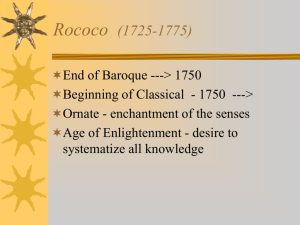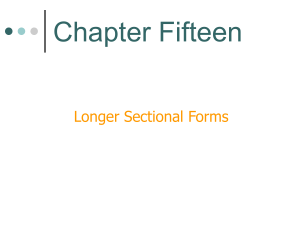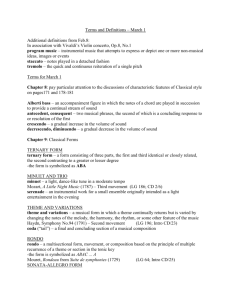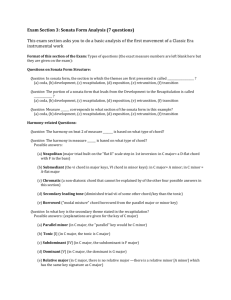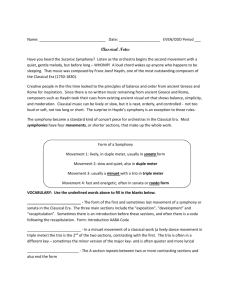Midcentury Instrumental Music PPT
advertisement
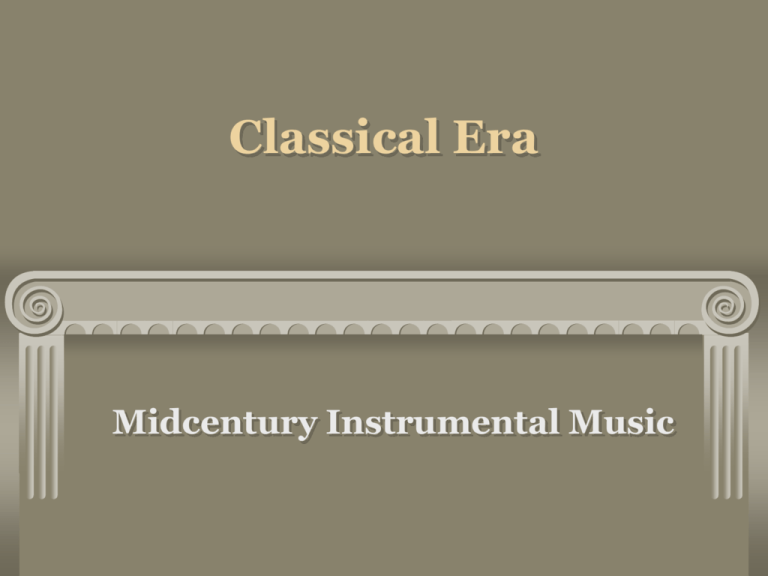
Classical Era Midcentury Instrumental Music STYLISTIC TRANSFORMATIONS Introduction of a new instrument, the fortepiano Contrasted with strings and winds Favored by amateurs and rising middle class Development of the “Accompanied Sonata” Domenico Scarlatti 1685-1757 Sonata in D Major (1749) NAWM pp. 59 C.P.E. Bach (1714-1788) Sonata in A Major, H. 186 (1779) NAWM pp. 64-67 Created the new performance idiom for the piano (fortepiano) Influenced the great Viennese composers of the Classical period with regards to form, style and compositional devices. Essay on the true art of playing the keyboard is still used as a primer for learning Classical Style. “There can be no art without form.” Igor Stravinsky The Classical Sonata Form: Three or Four Movements Following Sonata Allegro Form Important genre for amateurs The Sonata Cycle Movement I: Long Dramatic, Sonata Form: Allegro fast Movement II: Slow and lyrical, Theme and Variations or ABA. Andante, Adagio, or Largo Movement III: Minuet and Trio (18thC.) Minuet and Scherzo (19thC.), Allegretto or Allegro Movement IV: 18th C = lively and happy ending, Sonata Allegro, Sonata Rondo, Theme and Variations. Very Fast. Allegro, Vivace, Presto. Grand Finale 19th C. Triumph Forms of Movements Theme and Variation Rondo Minuet and Trio Sonata-allegro form New Style From 1770’s – 80’s Composite bass line changed to more independent parts for the bass viol, bassoon, cello. Change from the “overture sinfonia” to the “concert sinfonia”. Both in function and label. Sinfonia is a stand alone piece by this time. New Style From 1770’s – 80’s New style of orchestration. In baroque the winds doubled the strings. Now winds become independent in the partiture. Given priority with the main themes. Not simply a garnish to the string section. Changes in the Classical Symphony Shift in the function and valuation of the symphony. Move from introductions to theatre, plays, operas, civic events. Move to a piece intrinsic in itself. Symphony for Symphony’s sake. Johann Stamitz (1717-1757) Founder of the Mannheim School Sinfonia a 8 in E-flat Major ( 1755 ) NAWM pp. 73 Giovanni Battista Sammartini (1701-1775) Symphony in F Major (1730?) NAWM pp. 68 Symphony Format MOOD TEMPO FORM KEY Mvt 1 serious fast sonata tonic Mvt 2 calm slow sonata, NOT tonic th & var, ABA Mvt 3 dancelike or scherzo moderate or fast minuet & trio Mvt 4 lighter fast sonata or tonic sonata-rondo tonic Sonata-Allegro Form Sonata Form exposition usually repeated tonic theme 1 theme 2 recapitulation development transition 2 theme 1 theme 2 Sonata Form (First Movement) Exposition (A) Development (B)____ Recapitulation (A) First theme in home key Develops material from the exposition First theme restated in home key Bridge modulates to Modulation to foreign keys Bridge to Second theme in contrasting key Fragmentation or manipulation of thematic ideas Second theme transposed to home key Mozart: Piano Sonata in A maj. K. 331, III Rondo form Janissary influence Use of Czech folk song Last movement “alla turka” Swirling movement, leaping melodies, drones Images of bells, triangles of a Janissary band. Beethoven Piano Sonata in C minor. Pathetique Beethovenian Pathos in each movement Dramatic quality, sudden dynamic changes Adagio section that is hymn-like 2nd and 3rd movements are in Rondo form Sonata-Allegro Form Mozart: 40 Symphony, 4 Movement th 1st Theme 2nd Theme Modulating Bridge th Development Recap Sonata-Allegro Form Symphony No. 5, Mvt. 1 Kamien, p. 193, CD #2 Exposition Development 1. 2. 3. 4. T1 B T2 CT •••— motive What instruments? Recapitulation Coda LONG! •••— New ideas What instruments? T1 B T2 Ct What? How? What change from Expos? Sonata form Symphony No. 5, Mvt. 1 Kamien, Exposition Development T1 B T2 CT •••— motive What instruments? What? How? Recapitulation LONG! T1 B T2 Ct •••— New ideas What What change instruments? from Expos? Sonata form Symphony No. 5, Mvt. 1 D e v e l 1.a. 1.b. •••— motive o p m e n t 2.a. 2.b.c.d. Based on Th 2 Horn call w/ new answer 2 notes of horn call! 1 note of horn call!! Theme 2 reminder 2.e. Reminder of Th 1 Symphony No. 5, Mvt. 1 Click for guided listening to the entire development. Symphony No. 5, Mvt. 1 D e v e l Based on Th 1 Th 1 New melody melody, &R motive R •••— motive is ubiquitous! o p m e n t Based on Th Reminder of Th 1 2 Horn call 2 notes w/ new answer of horn call! 1 note of horn call!! Reminder of Th 2 Back to 1 note Symphony No. 5, Mvt. 1 Click for guided listening to the recapitulation and coda. Symphony No. 5, Mvt. 1 R e c a p i t u l a t i o n Theme 1 Important addition Yes! It was an oboe. Now it continues w/ a short cadenza. Bridge Theme 2 4.a.b. Closing Th Subdued horns + Bassoons! •••— in accompaniment •••— motive is ubiquitous! Symphony No. 5, Mvt. 1 C o d a Long! based mostly on •••— motive some new ideas introduced Symphony No. 5, Mvt. 1 Exposition Development Recapitulation Coda T1 B T2 CT T1 B T2 Ct •••— motive What? •••— motive •••— motive •••— motive This movement is UNIFIED like no earlier piece had ever been! Listen to entire piece Symphony No. 5, Mvt. 2 I = contrasting key “time out,” lyrical double theme & variations (Why not a rondo?) A B A’ B’ A” (?) Ths A& B Mood? Instruments? A’’’ Coda Symphony No. 5, Mvt. 3 I = scherzo (“joke”) minuet & trio form & triple meter BUT character is rough and rollicking, not genteel A •••— motive R B A’ energy level? Perceived tempo? Texture? Dynamic? Virtuoso double bass Symphony No. 5 Bridge between mvts. 3 & 4 Listen for: timpani: •••— motive R repeated patterns--high strings ambiguous mode (How will this symphony end?) C minor? (turmoil, struggle, failure) C major? (victory, triumph, overcoming) Crescendo at end leads to Mvt 4 Symphony No. 5, Mvt. 4 Exposition Development Recapitulation Coda T1 B T2 CT T1 B T2 Ct •••— motive R! C Major! Triumphant mood What? How? •••— motive R a la mvt 3 VERY LONG! Earlier themes reviewed including •••— Symphony No. 5 Mvt 1: •••— motive used in every part of sonata form Cyclicism: •••— motive used in Mvts 1, 3, 3-4 bridge, 4. (It is even obscurely used in mvt 2!!!) Mvts 3 & 4 tied together by ambiguous bridge Sonata form Structure (organization) of a single movement (Introduction) Exposition Development Recapitulation (Coda) Sonata form Structure (organization) of a single movement (Introdu Exposition Development Recapitulation Mozart--Symphony No. 40 in G Minor, Mvt. 1 Sonata form Exposition presents musical material Th 1 B r More energy i faster d louder g Tonic key e Mood? Instrumentation? Transitions & modulates Accompaniment? Th 2 Closing Section Less energy slower R softer Away key Mood? Instrumentation? Accompaniment? Sonata form Exposition presents musical material Click to hear and track the Exposition. Sonata form Exposition presents musical material Th B Th Closing 1 r 2 Section i d g e transitions & modulates Sonata form Exposition Development presents musical expands on, works material with musical material Th B Th Closing theme(s) from expos 1 r 2 Section reworking of themes sense of conflict i modulations d g What? e How? transitions & modulates HOW might a composer work with the exposition’s raw material? Development checklist: Repeat theme Fragment theme (and use part of it) Use imitation Add counter melody Change tone color (instruments) Change dynamics Change theme’s rhythm Change theme’s character Change accompaniment Modulate (change key) Sonata form Development Th B Th Closing theme(s) from expos 1 r 2 Section reworking of themes sense of conflict i modulations d g What? e How? transitions & modulates Sonata form Development Entirely based on Theme 1 Theme repeated in different keys. Bassoon countermelody Dynamic? Dynamic? Dynamic? Dynamic? Who plays theme? Entire theme or part of it? Entire theme Motive or part? imitations. What instruments? What Tone color instruments? changes. Composition device Composition Provides device transition to Recapitulation. Sonata form Development Entirely based on Theme 1 Louder Softer Louder Softer Theme repeated in different keys. Theme in bass w/ violin countermelody. Theme fragmented. (MOTIVE) Motive inverted. Motive imitations. Tone color changes. Tone color changes. Bassoon countermelody Exchange! Imitation. Provides transition to Recapitulation. Repeated in several keys. Tone color changes. Imitation. Sonata form Exposition Development Recapitulation presents musical expands on, works reviews musical material with musical material material Th B Th Closing theme(s) from expos Th B Th Closing 1 r 2 Section reworking of themes 1 r 2 Section sense of conflict i i modulations d d g g What? e e How? transitions & transitions modulates Sonata form Exposition Development Recapitulation presents musical expands on, works reviews musical material with musical material material Th B Th Closing theme(s) from expos Th B Th Closing 1 r 2 Section reworking of themes 1 r 2 Section sense of conflict i i modulations d d g g What? e e How? transitions & transitions modulates Coda closes mvt How? What do you hear? Sonata form Unity & Contrast are balanced U (Introduction) Exposition Development Recapitulation (Coda) Th B Th Th B Th C&U C&U 1 1 2 2 C C LOG Mozart Symphony No. 40 in G Minor, K. 550, Mvt. 1 Symphony movement I = Sonata form What does “K. 550” mean? Symphony Origin: ca. 1700 OPERA 3-mvt. overtures (often called “sinfonias”) Early 1700s--sinfonias performed without operas 1740s--sinfonias written as separate works & 4th mvt added Symphony Format MOOD TEMPO FORM KEY Mvt 1 serious fast sonata tonic Mvt 2 calm slow sonata, NOT tonic th & var, ABA Mvt 3 dancelike or scherzo moderate or fast minuet & trio Mvt 4 lighter fast sonata or tonic sonata-rondo tonic K. 550 Symphony in G minor, No. 40 July 25, 1788 One of the last and most beautiful of the master. Labeled “Romantic” by the people of the time for Intensity Chromaticism Unconventionality Thematic development Abundance of Ideas Ambiguity. A Roadmap for Form: The First Movement Sonata allegro. Exposition. Theme for violins in Gminor. Three note motive that is prime for development, sequence. Transition coupled with crescendo to go into the second theme in Bflat major. Build up of tension. Codetta keeps the listener in the contrasting key. Development: Develops the three note motive from the beginning. Changes melody. Combines motives. Sequences downward. Inversion of motives. Build up of tension. Recapitulation Follows the exposition. G-minor remains the home key. Tender… this is a change from convention. Most composers would go to G major just to end the work in a triumphant sound. Structure of Music Melody carried the interest Form still needed to give meaning Note power of the human voice Instrumental music uses strong melody as power
